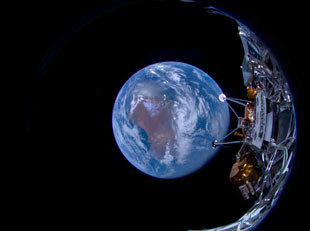By THE INDEPENDENT UG
LOS ANGELES | Xinhua | U.S. company Intuitive Machines’ inaugural lunar lander made contact with the Moon on Thursday, marking the first American spacecraft to achieve this feat in over 50 years.
The unmanned lander, named Odysseus, successfully touched down at the lunar South Pole at 6:23 p.m. Eastern Time, as confirmed by NASA.
Following initial troubleshooting of communications, flight controllers have verified that Odysseus is upright and has commenced transmitting data, according to Intuitive Machines.
“We are currently in the process of downlinking the initial images from the lunar surface,” the company announced via social media.
Odysseus is tasked with carrying NASA science payloads along with other commercial payloads to the moon. “These instruments will lay the groundwork for future human exploration of the Moon under Artemis,” NASA emphasized.
“Today, America has returned to the Moon for the first time in half a century,” expressed NASA Administrator Bill Nelson on X, formerly Twitter.
On the eighth day of its quarter-million-mile journey, Intuitive Machines executed a flawless landing, Nelson added.
Upon its lunar touchdown, the lander will commence drilling operations, NASA stated.
Odysseus was launched aboard a SpaceX Falcon 9 rocket last Thursday from NASA’s Kennedy Space Center in Florida. The mission, known as IM-1, represents Intuitive Machines’ inaugural robotic flight to the moon’s surface.
The Lander features a tall hexagonal cylinder with six landing legs and is capable of transporting 100 to 130 kg of payload to the surface, according to NASA.
It utilizes solar panels to generate 200 watts of power on the surface. Propulsion and landing employ liquid methane as fuel and liquid oxygen as an oxidizer.
The mission’s scientific objectives include studying plume-surface interactions, conducting radio astronomy, and examining space weather interactions with the lunar surface. Additionally, it will demonstrate precision landing technologies and communication and navigation node capabilities, according to NASA.
NASA is collaborating with various U.S. companies to deliver science and technology to the lunar surface through the Commercial Lunar Payload Services initiative.
The most recent U.S. moon landing mission occurred in December 1972 when Apollo 17 touched down on the lunar surface, marking the final mission of the Apollo Program.
In January of this year, another private American company, Astrobotic Technology, attempted to achieve the first U.S. lunar landing in over 50 years by sending a spacecraft to the Moon. However, the lander, named Peregrine, encountered propulsion issues post-launch and ultimately failed to land on the Moon. ■







Discussion about this post